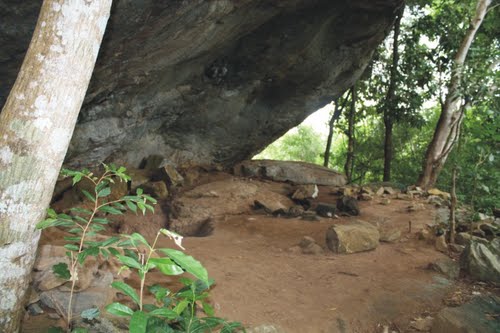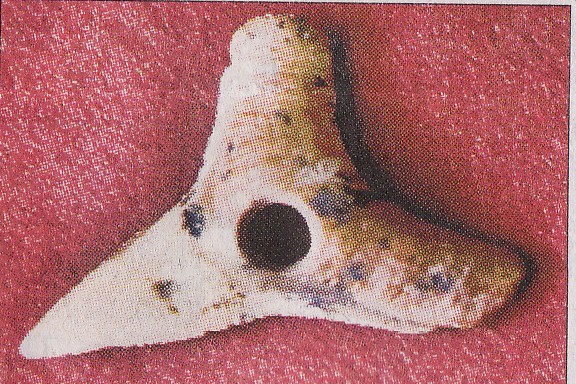Alawala Caves – prehistoric archeological treasure trove – By Arundathie Abeysinghe
 Situated in close proximity to Gampaha in the Western Province, discovery of two pre-historic human remains and several artifacts in Alawala Caves dating to prehistoric periods reveal valuable archeological data…
Situated in close proximity to Gampaha in the Western Province, discovery of two pre-historic human remains and several artifacts in Alawala Caves dating to prehistoric periods reveal valuable archeological data…
Initially, these artefacts were discovered by a team of archaeology scholars and their students from the Postgraduate Institute of Archaeology (PGIAR), University of Kelaniya. The team comprised of archaeologists, chemists, botanists as well as geologists.
According to scholars, the finds at Alawala Caves include fragments of a skull, jawbones with teeth, including loose teeth. Scholars are of the view that these artefacts date to pre-historic era 13,000 B.C.E. Archaeologists are of the view that these remains may reveal valuable data about the pre-historic past of Sri Lanka, including a different concept of our history.
According to archaeologists, shark tooth ornament seems too small and delicate to have survived many centuries unaltered, and their bones had been scattered in the tranquil cave and had been unearthed, in pieces. Potshards, bone tools, seeds including remains of the animals they feasted had been mingled with the dust.
Amount of wear and tear on the surfaces of the molars and the proportions of the jawbones including skull fragments, indicate that there had been two prehistoric humans buried in these caves and one of them was a young man in his late twenties and the other, an older woman approximately 40 years old. Red ochre has been applied to the outside as well as the inside of the skull fragments, a sign that the remains were part of some ritual. The application of red ochre is considered as an unusual sign by scholars.
There had also been traces of red ochre and other minerals such as graphite and mica beside the skeletal remains. Tools made of bone and stone, tiny, yet sharp, indicate the primitive technology utilized by hunter gatherers during that era. Scholars are of the view that these tools would have been utilized for hunting and thereafter, for skinning the animals they hunted.
Meanwhile, matching scrape marks on the bones indicate that the tools were utilized to separate the meat and marrow from the bones as the animal remains belong to small edible mammals and birds. These primitive tools would have been useful as arrowheads for removing seeds from inside the nut as well as to make new implements. The bones of giant squirrels and monkeys, including vertebrae belonging to pythons and fish have also been found in the caves.
According to some scholars, the two ancient humans had also been to the sea (located approximately 30 kilometers away from the caves) as there had been some sea shells inside the cave, similar to artefacts found in *Kitulgala Beli Lena Cave.
Among the animal remains, there had also been diverse varieties of snails and Ceylon breadfruit (Artocarpus nobilis – commonly known as “wild breadfruit”) seeds. Scholars are of the view that breadfruit seeds would have been roasted before being eaten. Among the remains in the caves, there had also been ancient hearths indicating this theory. A rock boulder, approximately 1.8 – 2 meters (6 or 7 feet) in diameter dotted with spitted holes, which would have been utilized for grinding had also been found inside the caves.
According to archaeo-chemists, shards of pottery found at the location indicate Sri Lanka’s transition from *Stone Age to *Metal Age.
Currently, the first phase of the excavation is almost completed and the team of researchers aim to study the surroundings, to identify species of fauna and flora that remain in the area as well as the interactions of humans who live in the location at present, including their interactions with their surroundings. Scholars are of the view that these measures would assist ethnoarchaeologists to recreate the entire landscape and the habitat.
This project on Alawala Caves is a study of the landscape, fauna and flora including the prehistoric artefacts as well as a valuable study of the lifestyle of our forefathers…
- Metal Age – This epoch commenced with the first large-scale smelting of metal (metallurgy or the working of metal through smelting) that let early human societies to utilize hardy materials to produce new tools that increased the efficiency of labor and contributed to the advancement of human social structures. Metal Age also led to the rise of human civilization due to the development of metal tools. The most prominent metals utilized during this period were copper, bronze and iron. This period is divided into three stages: Copper Age, Bronze Age and Iron Age. During Metal Age, people made a variety of metal objects and invented new techniques for making clay pottery. The most characteristic examples are beaker pots.
- Stone Age – A broad prehistoric period during which humans utilized primitive stone tools. During this period, humans utilized stones to make stone tools comprising an edge, a point or percussion surface. Lasting approximately 2.5 million years, the Stone Age ended around 5,000 years ago when humans in the Near East commenced working with metal and making tools and weapons from bronze. Stone Age terminated between 4,000 BC and 2,000 BC. During Stone Age, humans shared the Earth with several, now-extinct hominin relatives, including Neanderthals and Denisovans.
Kitulgala Beli Lena Cave – archaeological treasure trove – By Arundathie Abeysinghe – November 8, 2020









